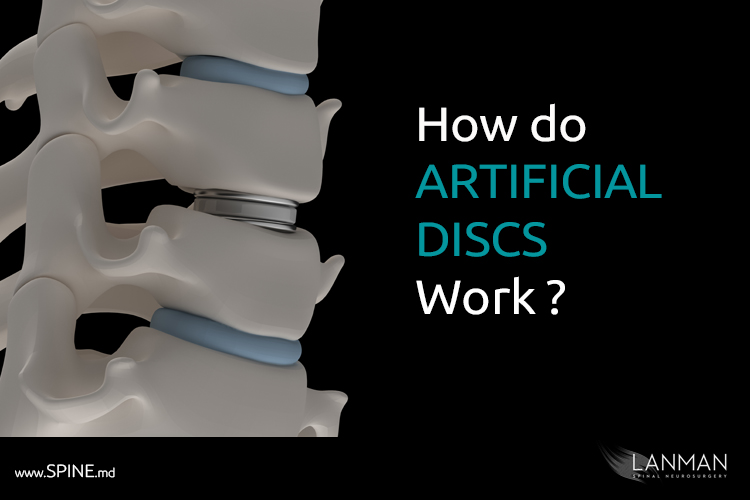Artificial disc replacement surgery is a medical procedure where a surgeon removes a herniated spinal disc and replaces it with an implant device.
Between every pair of vertebrae (bones in your spine) is a semi-flexible spinal disc that can be damaged or degenerate. Your surgeon may recommend surgery when material from a damaged disc impinges onto one of the many nerves that emanate from the spinal cord. Impinged (compressed) nerves often lead to chronic pain, tingling, numbness, and weakness.
Remember your high school introduction to human anatomy, and you may recall that the spine is a column of bones protecting the spinal cord. The size of the bones range from larger than a fist at the base of the back (lumbar) and mid-back (thoracic), to about half that size in your neck (cervical).
Segmentation of the spine is facilitated by the spinal discs that allow the body to flex, twist and bend without damage to the spinal cord. Regular healthy spinal discs prevent the vertebrae from bumping into each other and also keep the whole system of bones together.
When discs herniate, sometimes a patient is fortunate, and there’s little or no nerve compression, however, for most patients, this is not the case. It is always more likely when discs are damaged—by herniation or other degeneration—that patients will experience long-term pain or soreness at the location of the herniation. If the nerve impingement continues, additional symptoms may appear, such as numbness or tingling in the arms (if cervical) or the legs (if lumbar). Other symptoms may include a burning sensation along extremities (arms, legs) combined with weakness which may indicate nerve pinching.
General designs of artificial discs come in two basic formats. One design imitates natural discs by using semi-flexible material between two plates. Another favorite design follows a ‘ball and socket’ concept to limit the structural stress imposed on the prosthesis disc. All artificial disc design and construction follows decades of medical experience. In fact, artificial discs are similar in many ways to other implants used for hip and knee replacement surgery and other prostheses. Medical-grade metals, medical-grade biopolymers, or often a combination of the two, comprise the construction materials of an artificial disc. While knee and hip implants may need to be replaced after 25 years, artificial discs will last for about 70 years, which is basically a lifetime for most patients.
No matter the detail of the design or the procedure itself, the goal for artificial disc replacement is to maintain natural flexibility and range of motion of original discs for the patient. So, leaving an untreated degenerative or herniated disc seems counter-intuitive to me. It can also be dangerous to your nerve health. It is impossible to replace lost nerve, but a disc can be easily replaced in one 6-hour surgical procedure.
Artificial disc replacement surgery is almost always performed as an ‘anterior’ procedure; we go through the front of the abdomen for lumbar (lower back) and through the front of the throat for cervical (neck). You’ll be discharged from the hospital or surgery center in less than 1 day (some are even outpatient), and it may take between 3 to 6 weeks before you can resume with most personal activities. Full recovery may take about 2 months. This contrasts with spinal fusion which can take 3 to 6 months before full recovery.
Another important distinction for artificial discs is the vastly superior postoperative results compared with patients who have spinal fusion. While artificial disc replacement is newer than fusion, clinical studies reveal far better patient outcomes in every way, including reduction of pain, neurological function, and—most important—fewer revision surgeries.
I have been involved in several clinical studies of ADR—both as a co-participant and as the principal investigator—since its approval by the FDA in 2005. In one of these studies, my colleagues compared patients who had artificial disc replacement surgery with those who had fusions. We found that disc replacement patients saw a success rate of 81.4%. Of those who underwent fusion, the success rate was 69.4%.
However, it is my personal experience with these procedures that gives me the best insight into what patients really need. I’ve had three artificial discs and one spinal fusion. From this experience I know that patients want artificial disc replacement because it produces less post-op discomfort and pain without the kind of loss of motion I experienced with my single-level fusion.
This knowledge caused me to be a vocal advocate for artificial disc replacement surgery. I even founded the Lanman Foundation earlier this year to help pay for artificial disc replacement surgeries for our military veterans who need it. We’re now at a point where we can confidently reverse fusions; replace them with artificial discs.
I use all my education and training as a surgeon to help my patients be greater than better. But it is my experience as a patient that leaves me completely convinced that artificial disc replacement surgery is the best way to go to achieve the best results for many of my patients.






